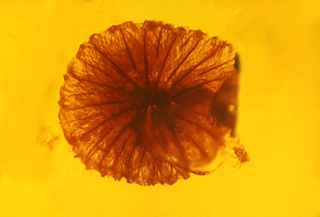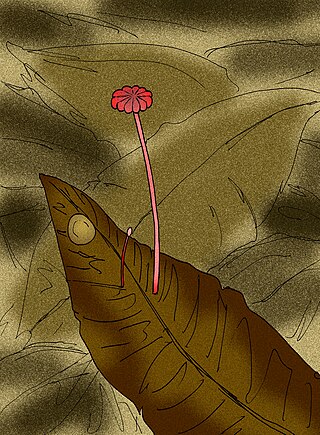Related Research Articles

Cyathea cranhamii is an extinct species of tree fern. It was described based on permineralised sori from the Early Cretaceous deposits of Apple Bay in Vancouver Island, British Columbia.

The Agaricomycetes are a class of fungi in the division Basidiomycota. The taxon is roughly identical to that defined for the Homobasidiomycetes by Hibbett & Thorn, with the inclusion of Auriculariales and Sebacinales. It includes not only mushroom-forming fungi, but also most species placed in the deprecated taxa Gasteromycetes and Homobasidiomycetes. Within the subdivision Agaricomycotina, which already excludes the smut and rust fungi, the Agaricomycetes can be further defined by the exclusion of the classes Tremellomycetes and Dacrymycetes, which are generally considered to be jelly fungi. However, a few former "jelly fungi", such as Auricularia, are classified in the Agaricomycetes. According to a 2008 estimate, Agaricomycetes include 17 orders, 100 families, 1147 genera, and about 21000 species. Modern molecular phylogenetic analyses have been since used to help define several new orders in the Agaricomycetes: Amylocorticiales, Jaapiales, Stereopsidales, and Lepidostromatales.

The Pleosporales is the largest order in the fungal class Dothideomycetes. By a 2008 estimate it contains 23 families, 332 genera and more than 4700 species. The majority of species are saprobes on decaying plant material in fresh water, marine, or terrestrial environments, but several species are also associated with living plants as parasites, epiphytes or endophytes. The best studied species cause plant diseases on important agricultural crops e.g. Cochliobolus heterostrophus, causing southern corn leaf blight on maize, Phaeosphaeria nodorum causing glume blotch on wheat and Leptosphaeria maculans causing a stem canker on cabbage crops (Brassica). Some species of Pleosporales occur on animal dung and a small number occur as lichens and rock-inhabiting fungi.
Rhizochaete is a genus of nine species of poroid crust fungi in the family Phanerochaetaceae. The genus is closely related to Phanerochaete. Aside from the widespread Rhizochaete radicata and the Asian species R. borneensis, the remaining Rhizochaete fungi are found in North and South America.

Coprinites is an extinct monotypic genus of gilled fungus in the Agaricales family Agaricaceae. At present it contains the single species Coprinites dominicana.

Archaeomarasmius is an extinct genus of gilled fungus in the Agaricales family Tricholomataceae, containing the single species Archaeomarasmius leggetti. It is known from two fruit bodies recovered from amber, one consisting of a complete cap with a broken stem, the other consisting of a fragment of a cap. The cap has a diameter ranging from 3.2 to 6 mm, while the stem is 0.5 mm (0.02 in) thick. Spores were also recovered from the amber, and are broadly ellipsoid to egg-shaped, measuring roughly 7.3 by 4.7 μm. The species, which resembles the extant genera Marasmius and Marasmiellus, is inferred to have been saprobic on plant litter or other forest debris.
Aureofungus is an extinct monotypic genus of gilled fungus in the order Agaricales. At present it contains the single species Aureofungus yaniguaensis.
Margaretbarromyces is an extinct monotypic genus of pleosporale fungus of uncertain family placement. At present it contains the single species Margaretbarromyces dictyosporus.
Appianoporites is an extinct monotypic genus of fungus in the Agaricomycetes family Hymenochaetaceae. At present it contains the single species Appianoporites vancouverensis.
Mycetophagites is an extinct fungal genus of mycoparasitic in the order Hypocreales. A monotypic genus, it contains the single species Mycetophagites atrebora.
Entropezites is an extinct monotypic genus of [hypermycoparasitic] fungus in the order Hypocreales. At present it contains the single species Entropezites patricii.

The Princeton Chert is a fossil locality in British Columbia, Canada, which comprises an anatomically preserved flora of Eocene Epoch age, with rich species abundance and diversity. It is located in exposures of the Allenby Formation on the east bank of the Similkameen River, 8.5 km (5.3 mi) south of the town of Princeton, British Columbia.
Pinus driftwoodensis is an extinct species of conifer in the pine family solely known from early Eocene sediments exposed in south central British Columbia. The species was described from an isolated fossil ovulate cone associated with a series of wood, needles and pollen cones in chert. P. driftwoodensis was the eighth pine species to be described from a permineralized ovulate cone and the second from the Okanagan highlands.
Suciacarpa is an extinct genus of asterid flowering plants in the order Cornales. It is known from the fossil species Suciacarpa starrii and Suciacarpa xiangae, both found in Western North America.
Daedalea ryvardeniana is a neotropical species of poroid fungus in the family Fomitopsidaceae. Found in Brazil, it was described as new to science in 2012.
Hughmillerites is a fossil cypress, found in the Late Jurassic of Scotland and Early Cretaceous of Canada.
The paleoflora of the Eocene Okanagan Highlands includes all plant and fungi fossils preserved in the Eocene Okanagan Highlands Lagerstätten. The highlands are a series of Early Eocene geological formations which span an 1,000 km (620 mi) transect of British Columbia, Canada and Washington state, United States and are known for the diverse and detailed plant fossils which represent an upland temperate ecosystem immediately after the Paleocene-Eocene thermal maximum, and before the increased cooling of the middle and late Eocene to Oligocene. The fossiliferous deposits of the region were noted as early as 1873, with small amounts of systematic work happening in the 1880-90s on British Columbian sites, and 1920-30s for Washington sites. A returned focus and more detailed descriptive work on the Okanagan Highlands sites revived in the 1970's. The noted richness of agricultural plant families in Republic and Princeton floras resulted in the term "Eocene orchards" being used for the paleofloras.
Uhlia is an extinct genus of coryphoid palm containing a single species Uhlia allenbyensis. The species is known from permineralized remains recovered from the Princeton Chert in British Columbia, Canada. Leaves of Uhlia have "tar spot"-like fungal infections of the extinct ascomycete Paleoserenomyces, which in turn are hyperparasitized by the ascomycete Cryptodidymosphaerites.
Paleoserenomyces is an extinct monotypic genus of pleosporale fungus of uncertain family placement. When described it contained the single species Paleoserenomyces allenbyensis. The genus is solely known from the Early Eocene, Ypresian aged, Princeton Chert deposit of the Allenby Formation. Palaeoserenomyces is one of only three described fossil fungus species found in the Princeton Chert, being a tar spot like parasite of the fossil palm Uhlia allenbyensis, and is host for the hyperparasite Cryptodidymosphaerites princetonensis.
Cryptodidymosphaerites is an extinct monotypic genus of pleosporale fungus of uncertain family placement. When described it contained the single species Cryptodidymosphaerites princetonensis. The genus is solely known from the Early Eocene, Ypresian aged, Princeton Chert deposit of the Allenby Formation. Cryptodidymosphaerites is one of only three described fossil fungus species found in the Princeton Chert, and is a hyperparasite of Palaeoserenomyces allenbyensis, itself a tar spot-like parasite of the fossil palm Uhlia.
References
- 1 2 3 4 5 6 7 Smith, S. Y.; Currah, R. S.; Stockey, R. A. (2004). "Cretaceous and Eocene poroid hymenophores from Vancouver Island, British Columbia". Mycologia. 96 (1): 180–186. doi:10.2307/3762001. JSTOR 3762001. PMID 21148842.
- ↑ Currah, R. S.; Stockey, R. A.; LePage, B. A. (1998). "An Eocene tar spot on a fossil palm and its fungal hyperparasite". Mycologia. 90 (4): 667–673. doi:10.2307/3761225. JSTOR 3761225.
- ↑ Mindell, R. A.; Stockey, R. A.; Beard, G.; Currah, R. S. (2007). "Margaretbarromyces dictyosporus gen. Sp. Nov.: A permineralized corticolous ascomycete from the Eocene of Vancouver Island, British Columbia". Mycological Research. 111 (6): 680–4. doi:10.1016/j.mycres.2007.03.010. PMID 17601718.